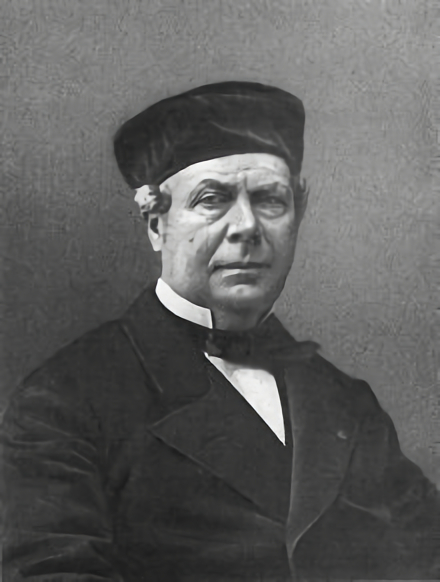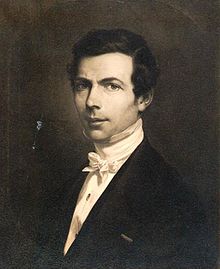A. Cavaille-Coll
| Founded/Born - Closed/Death | 1834 - 1899 |
|---|---|
| Still active? | no |
Aristide Cavaille-Coll designed the concept of the symphonic organ. He mastered the classic organ building craft and was technically versatilely gifted. In many aspects, he stayed conservative and held on time attested approaches. On the other hand he was not afraid to experiment and introduce new inventions. Soon after arrival in Paris, he succeeded in the competition to build the new organ for the St. Denis basilica. He reportedly was done with the successful design in just two days. The work progress was slow however, especially with the troublesome tracker action. To his luck, Aristide met with Charles Barker in Paris, who improved Hamilton's invention of the pneumatic lever, which after touching the key, opens air entry into a pneumatic motor, filling air into wedge bellows manipulating tracker action or other devices. This lever, multiplying the force of fingers applied on the keyboard, allowing for the development of larger, more powerful organs still responsive to the human hand with more registers, couplers and combinations than was possible before. Also, the organ console could be built detached from the main organ.
Cavaille-Coll immediately recognized the importance of this invention for organ building. The instrument in St. Denis basilica was finalized in 1841 and was met with tremendous success. It became the fashion to hold private concerts there featuring prominent musicians with invited guests from political and economic circles. Only 30 years old, Aristide was awarded a Societe d' Arts silver medal "...for the improvements he introduced to the organ building as exemplified in the royal church St. Denis." It's of interest to note that Charles Barker later deserted and joined another organ builder Dublaine et Callinet and together they built a monumental organ for St. Eustache church in 1844. By a turn of unfortunate events, during repair work on the organ, Barker jolted a lighted candle that fell into the St Eustache instrument when it was only six months old and the fire destroyed it. This ultimately led to the bankruptcy of the firm.
Cavaille-Coll recognized the importance of different air pressure needed for different registers. He divided therefore the airchest in 2 sections: one for labial and and wide mouth pipe voices (jeux de fonds), and the other one for narrow mouth pipe voices, mutations, mixtures and reeds (jeux de combinaison). Each sections had a separate air supply with its specific air pressure. In this way, “air stealing” phenomenon between these two groups was avoided. A simple foot lever (appels) above the pedalboard enabled joining the windchests. Principals are acoustically diverse due to various pipe mouth width in the English organ building way.By combining four diverse basic voices (montre, flute, bourdon, gambe) in the 8' position, the Romantic symphonic acoustic ideal was achieved. The registers in pedal are plentiful, usually also with solo voices.
Cavaille-Coll built over 600 organs. He built not only large instruments for Paris and other French cities but also many smaller choir instruments, chamber organs and other instruments for school and institutions. During his time, it was fashionable to have an organ built even in homes. Especially in the early stage of his career, in addition to organs, Cavaille-Coll built so called poikilorgues, which were a type of reed instruments with the possibility of dynamic expression.
Besides the aforementioned instrument in St. Denis, it is necessary to refer to the organ in Ste. Clotilde basilica related to the work of Cesar Franck. In 1863, a five manual organ for St. Sulpice was built (Widor, Dupre). More of his works can be found in Ste. Madeleine or Ste. Trinite. His most representative organ in Notre-Dame Cathedral in Paris was finished in 1868. Since that time it was rebuilt numerous times, electrified and equipped with a new console. He exhibited an extraordinary monumental organ at Trocadero Palace during the World Exhibition of 1878. It attracted the best organists which used it to play in a series of fourteen concerts. The organ of St. Etienne in Caen, preserved in its almost original form, was built in 1882 and later in 1890 the four manual organ was finished in Rouen.
The lifelong dream of pious Cavaille-Coll was to build an organ for St. Peter in Rome. He designed and continually improved the concept which was presented to three popes. The work of Cavaille-Coll was known and appreciated in Rome, however, his dream never realized. And so, to this day, there is an indistinct organ not corresponding to its impressive location in the basilica.
Cavaille-Coll immediately recognized the importance of this invention for organ building. The instrument in St. Denis basilica was finalized in 1841 and was met with tremendous success. It became the fashion to hold private concerts there featuring prominent musicians with invited guests from political and economic circles. Only 30 years old, Aristide was awarded a Societe d' Arts silver medal "...for the improvements he introduced to the organ building as exemplified in the royal church St. Denis." It's of interest to note that Charles Barker later deserted and joined another organ builder Dublaine et Callinet and together they built a monumental organ for St. Eustache church in 1844. By a turn of unfortunate events, during repair work on the organ, Barker jolted a lighted candle that fell into the St Eustache instrument when it was only six months old and the fire destroyed it. This ultimately led to the bankruptcy of the firm.
Cavaille-Coll recognized the importance of different air pressure needed for different registers. He divided therefore the airchest in 2 sections: one for labial and and wide mouth pipe voices (jeux de fonds), and the other one for narrow mouth pipe voices, mutations, mixtures and reeds (jeux de combinaison). Each sections had a separate air supply with its specific air pressure. In this way, “air stealing” phenomenon between these two groups was avoided. A simple foot lever (appels) above the pedalboard enabled joining the windchests. Principals are acoustically diverse due to various pipe mouth width in the English organ building way.By combining four diverse basic voices (montre, flute, bourdon, gambe) in the 8' position, the Romantic symphonic acoustic ideal was achieved. The registers in pedal are plentiful, usually also with solo voices.
Cavaille-Coll built over 600 organs. He built not only large instruments for Paris and other French cities but also many smaller choir instruments, chamber organs and other instruments for school and institutions. During his time, it was fashionable to have an organ built even in homes. Especially in the early stage of his career, in addition to organs, Cavaille-Coll built so called poikilorgues, which were a type of reed instruments with the possibility of dynamic expression.
Besides the aforementioned instrument in St. Denis, it is necessary to refer to the organ in Ste. Clotilde basilica related to the work of Cesar Franck. In 1863, a five manual organ for St. Sulpice was built (Widor, Dupre). More of his works can be found in Ste. Madeleine or Ste. Trinite. His most representative organ in Notre-Dame Cathedral in Paris was finished in 1868. Since that time it was rebuilt numerous times, electrified and equipped with a new console. He exhibited an extraordinary monumental organ at Trocadero Palace during the World Exhibition of 1878. It attracted the best organists which used it to play in a series of fourteen concerts. The organ of St. Etienne in Caen, preserved in its almost original form, was built in 1882 and later in 1890 the four manual organ was finished in Rouen.
The lifelong dream of pious Cavaille-Coll was to build an organ for St. Peter in Rome. He designed and continually improved the concept which was presented to three popes. The work of Cavaille-Coll was known and appreciated in Rome, however, his dream never realized. And so, to this day, there is an indistinct organ not corresponding to its impressive location in the basilica.
No YouTube videos available.
Make this Notebook Trusted to load map: File -> Trust Notebook
https://www.sonusparadisi.cz/en/organs/france/caen-st-etienne.html
https://de.wikipedia.org/wiki/Aristide_Cavaill%C3%A9-Coll
https://de.wikipedia.org/wiki/Aristide_Cavaill%C3%A9-Coll
 Pipe Organ Map
Pipe Organ Map

